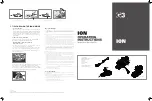
012
013
Alaska
25° N
0°– 13°
13°– 26°
26°– 37°
37°– 45°
19° N
21° N
26° N
20° N
27° N
28° N
29° N
30° N
31° N
32° N
23° N
34° N
35° N
36° N
37° N
38° N
39° N
40° N
41° N
42° N
43° N
44° N
45° N
46° N
47° N
48° N
60° N
49° N
Washington
Oregon
California
Nevada
Arizona
Utah
New Mexico
Kansas
Colorado
Oklahoma
Texas
North Dakota
South Dakota
Nebraska
Idaho
Montana
Wyoming
61° N
62° N
63° N
64° N
65° N
70° N
66° N
67° N
68° N
69° N
Hawaii
The Solar charge in a battery pack won’t last forever, the off–grid
system relies on stored daylight for autonomy. Angling your solar
panels properly can boost the power intake of your lights. You want
to angle your solar panels at a tilt equal to the area’s latitude.
Tip
You can increase the tilt 15° in the winter or decrease 15° in the summer.
In this way you can get the maximum sunlight to recharge the battrey bank.
Strong sunlight
Nromal sunlight
Less sunlight
Key
The area will dictate the installation of the fixtures and will sometimes
prevent the lights from facing south.
But that’s okay! Panels facing West
& East won’t get as much light as a Southern facing panels but will still
collect a good amount of sunlight. A North–facing panel also works, but
it will take longer to charge than any other direction. This would mean that
the solar charge will be less optimal if installations are facing that way.
0°– 13°
13°– 26°
13°– 26°
37°– 45°
45°
37°– 45°
Arkansas
Louisiana
Mississippi
Alabama
Georgia
South
Carolina
North
Carolina
Virginia
West
Virginia
Kentucky
Illinois
Wisconsin
Minnesota
Iowa
Missouri
Michigan
Indiana
Ohio
Pennsylvania
New York
Massachusetts
Rhode Island
Connecticut
New Jersey
Delaware
Maryland
Tennessee
Florida
World Wide Panel Angles
Best Facing Direction of Solar Panel
Best
Work
OK
OK
New Hampshire
Vermont
Maine
26°– 37°
26°– 37°
09
Panel Angle





























